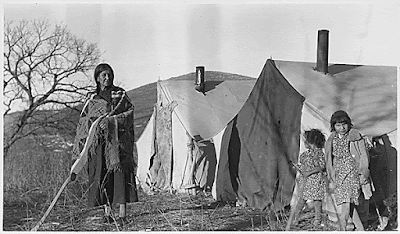Digitized Native American Reservation Photographs
Cara Burnidge
Today, the National Archives's "Spotlight on the Records" highlighted digitized records that may be of interest to readers: Native American Reservation Photographs.
Most of the photographs are found in Record Group 75: Records of the Bureau of Indian Affairs, 1793-1999, but other federal agencies also took part in documenting life on reservations. Daily life is often the focus of the photographs, but this can range from farming and families to sports to protests. The picture included here is one of over 5,000 digitized photographs of Standing Rock Sioux Tribe in North Dakota. For those interested in connecting the past to the present or including Native Americans as a part of American history well beyond the colonial era, these photographs are an excellent resource to share with students.
In addition to the photos of Standing Rock, there are also collections of Spirit Lake Sioux at Fort Trotten (North Dakota), Sisseton-Wahpeton Oyate on the Lake Travers Reservation (South Dakota), Oglala Sioux on Pine Ridge Reservation (South Dakota), Eastern Shoshone and Northern Arapahoe at Wind River Agency (Wyoming), and areas near Fort Berthold Indian Reservation (North Dakota) affected by flooding during the construction of Garrison Dam.
Deep dives into these archives can be a helpful exercise with students, as Emily Clark has noted in "Taking Class to the Archives." These digitized photographs might be one way to bring the archives to your students. In Emily's class, the archives became an opportunity to do the the work of a historian narrating the past. These photographs certainly can provide a similar opportunity. Another possibility, and one encouraged by NARA, is for students to become Citizen Archivists, tagging digitized photos to identify and describe the subject, objects, and themes. Spending some time in class tagging photos together is another way to have the kind of "Adventures in Materiality" that Sarah Dees had in her Museums course. By tagging together, a class might be able to practice seeing and analyzing the materiality, embodiment, and production of culture in the past but also in the present through the work (or outsourced work) of the National Archives.*
*H/T Adam Park who suggested David Morgan's "Religion and Embodiment in the Study of Material Culture," in ORE Religion in America, 10.1093/acrefore/9780199340378.013.32
 |
| "Indian woman and young girls in front of tents," Dept. of Interior, Bureau of Indian Affairs, Standing Rock Agency, September 17, 1947 [285835] |
Most of the photographs are found in Record Group 75: Records of the Bureau of Indian Affairs, 1793-1999, but other federal agencies also took part in documenting life on reservations. Daily life is often the focus of the photographs, but this can range from farming and families to sports to protests. The picture included here is one of over 5,000 digitized photographs of Standing Rock Sioux Tribe in North Dakota. For those interested in connecting the past to the present or including Native Americans as a part of American history well beyond the colonial era, these photographs are an excellent resource to share with students.
In addition to the photos of Standing Rock, there are also collections of Spirit Lake Sioux at Fort Trotten (North Dakota), Sisseton-Wahpeton Oyate on the Lake Travers Reservation (South Dakota), Oglala Sioux on Pine Ridge Reservation (South Dakota), Eastern Shoshone and Northern Arapahoe at Wind River Agency (Wyoming), and areas near Fort Berthold Indian Reservation (North Dakota) affected by flooding during the construction of Garrison Dam.
Deep dives into these archives can be a helpful exercise with students, as Emily Clark has noted in "Taking Class to the Archives." These digitized photographs might be one way to bring the archives to your students. In Emily's class, the archives became an opportunity to do the the work of a historian narrating the past. These photographs certainly can provide a similar opportunity. Another possibility, and one encouraged by NARA, is for students to become Citizen Archivists, tagging digitized photos to identify and describe the subject, objects, and themes. Spending some time in class tagging photos together is another way to have the kind of "Adventures in Materiality" that Sarah Dees had in her Museums course. By tagging together, a class might be able to practice seeing and analyzing the materiality, embodiment, and production of culture in the past but also in the present through the work (or outsourced work) of the National Archives.*
*H/T Adam Park who suggested David Morgan's "Religion and Embodiment in the Study of Material Culture," in ORE Religion in America, 10.1093/acrefore/9780199340378.013.32

Comments